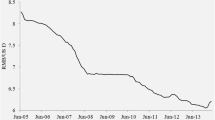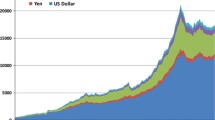Abstract
This paper analyses the international transmission of monetary policy in the case where all export prices are set in US dollars. “Dollar pricing” implies that the international effects of US monetary shocks are different from those of European shocks because of an asymmetric exchange rate pass-through to import prices. A dollar pricing model can explain the observed asymmetry in the transmission of monetary policy: US monetary policy affects US output more than European monetary policy affects European output. I also show that the current account is an important channel through which monetary policy affects welfare. The paper concludes that under dollar pricing a monetary expansion is a beggar-thy-neighbour policy.



Similar content being viewed by others
Notes
In this paper, in contrast to Schmidt (2006), there is no home bias in consumption, I abstract from capital formation, there is only one internationally traded asset, and the elasticity of substitution between goods produced in the same country is the same as the elasticity of substitution between goods produced in different countries.
On the other hand, De Grauwe and Costa Storti (2005) reject the hypothesis that the short-run output effects of monetary policy in the Eurozone are lower than in the US.
As mentioned in the introduction, the model is based on Betts and Devereux (2000).
In the presentation of the model that follows, the equations for the foreign country are identical to those of the home country unless they are explicitly discussed.
Since the model hitherto is identical to that of Betts and Devereux (2000), the first order conditions are the same as in their model.
For instance, in Schmidt (2006): “[w]elfare effects were derived as the discounted sum of all future utility changes compared to the steady-state path of utility.”
As typical in the literature, I neglect the utility derived from real balances.
Because preferences are identical across regions and the law of one price holds for all goods, the CPI-based real exchange rate is always constant.
In the Obstfeld and Rogoff (1995) model, the overall welfare effect of a monetary shock is \(\hat{U}_{Overall}=\hat{U}_{Overall}^{\ast }=\frac{\beta +\varepsilon (1-\beta )}{\theta }\left[ n\hat{M}+\left( 1-n\right) \hat{M} ^{\ast }\right] \). Using the same parameter values as in the present model, the previous equation implies that a monetary shock increases domestic and foreign utility by 0.083% in the Obstfeld and Rogoff (1995) model. This amounts to approximately half of the welfare gain of this model. Why? In the present model, the parameter value chosen for staggered pricing implies an average delay of four periods for pricing adjustment, while Obstfeld and Rogoff (1995) have prices that are sticky for one period. This implies a stronger liquidity effect of monetary policy in this model.
Pierdzioch (unpublished manuscript) extends the model of Betts and Devereux (2000) by the introduction of the Calvo price-setting framework. He analyses the positive effects of monetary shocks in the presence of full LCP. Thus, the model of this paper, in the LCP case, replicates the results of Pierdzioch (unpublished manuscript). In addition, I also analyse the welfare effects of monetary shocks.
Only the effects on output and consumption are shown. The setting of θ = 3 has virtually no impact on variables other than outputs, except for the fact that the welfare effects of the shock are different in the case of θ = 3. This is likely to be caused by the fact that this parameter also determines the initial level of output, implying that equilibrium output is far below the socially optimal level. Thus any increase in consumption is more likely to be welfare improving.
The consequences of varying \(\upgamma \) for the other variables than European output are purely quantitative.
References
Angeloni I, Kashyap AK, Mojon B, Terlizzese D (2003) The output composition puzzle: a difference in the monetary transmission mechanism in the Euro area and U.S. J Money Credit Bank 35:1265–1306
Backus DK, Kehoe PJ, Kydland FE (1992) International real business cycles. J Polit Econ 100:745–775
Betts C, Devereux M (2000) Exchange rate dynamics in a model of pricing-to-market. J Int Econ 50:215–244
Betts C, Devereux M (2001) The international effects of monetary and fiscal policy in a two-country model. In: Calvo G, Dornbusch R, Obstfeld M (eds) Money, capital mobility and trade: essays in honor of Robert Mundell. MIT, Cambridge
Calvo G (1983) Staggered prices in a utility maximizing framework. J Monet Econ 12:383–398
Corsetti G, Pesenti, P (2005) The simple geometry of transmission and stabilization in closed and open economy. Federal Reserve Bank of New York Staff Report 209
De Grauwe P, Costa Storti C (2005) Is monetary policy in the eurozone less effective than in the US? CESifo Working Paper 1606
Devereux M, Engel C, Tille C (2003) Exchange rate pass-through and the welfare effects of the euro. Int Econ Rev 44:223–242
Devereux M, Shib K, Xuc J (2007) Global monetary policy under a dollar standard. J Int Econ 71:113–132
Dornbusch R (1976) Expectations and exchange rate dynamics. J Polit Econ 84:1161–1176
ECU Institute (1995) International currency competition and the future role of the single European currency. Kluwer Law, London
Engel C (2002) Expenditure switching and exchange-rate policy. In: Gertler M, Rogoff K (eds) NBER macroeconomics annual 2002. MIT, Cambridge
Goldberg L, Tille C (2005) Vehicle currency use in international trade. NBER Working Paper No. 11127
Holman JA, Neumann RM (2002) Evidence on the cross-country transmission of monetary shocks. Appl Econ 34:1837–1857
Kim S (2001) International transmission of U.S. monetary policy shocks: evidence from VAR’s. J Monet Econ 48:339–372
Klein P (2000) Using the generalized schur form to solve a multivariate linear rational expectations model. J Econ Dyn Control 24:1405–1423
Lane P (2001) The new open economy macroeconomics: a survey. J Int Econ 54:235–266
Lane P, Ganelli G (2003) Dynamic general equilibrium analysis: the open economy dimension. In: Altug S, Chanda J, Nolan C (eds) Dynamic macroeconomic analysis. Cambridge University Press, Cambridge
Mendoza E (1995) The terms of trade, the real exchange rate, and economic fluctuations. Int Econ Rev 36:101–137
McCallum B (2001) Software for RE analysis. http://wpweb2.tepper.cmu.edu/faculty/mccallum/research.html
Obstfeld M (2002) Exchange rates and adjustment: perspectives from the new open economy macroeconomics. Monet Econ Stud 20:23–46
Obstfeld M, Rogoff K (1995) Exchange rate dynamics redux. J Polit Econ 103:624–660
Obstfeld M, Rogoff K (1996) Foundations of international macroeconomics. MIT, Cambridge
Obstfeld M, Rogoff K (2000a) New directions for stochastic open economy models. J Int Econ 50:117–153
Obstfeld M, Rogoff K (2000b) The six major puzzles in international finance: is there a common cause? NBER Macroeconomics Annual 15:341–390
Schmidt C (2006) International transmission effects of monetary policy shocks: can asymmetric price setting explain the stylized facts? Int J Financ Econ 11:205–218
Sutherland A (1996) Financial market integration and macroeconomic volatility. Scand J Econ 98:521–539
Sutherland A (2006) The expenditure switching effect, welfare and monetary policy in a small open economy. J Econ Dyn Control 30:1159–1182
Tavlas G (1997) The international use of the US dollar: an optimum currency area perspective. World Econ 20:730–747
Author information
Authors and Affiliations
Corresponding author
Additional information
Financial support from the Yrjö Jahnsson Foundation is gratefully acknowledged. I am grateful to Vesa Kanniainen, Mika Kortelainen, Anne Mikkola, Tapio Palokangas, Jouko Vilmunen and seminar participants at the University of Helsinki and HECER for comments. In addition, I am especially grateful to the referees for their many useful comments.
Rights and permissions
About this article
Cite this article
Tervala, J. The International Transmission of Monetary Policy in a Dollar Pricing Model. Open Econ Rev 21, 629–654 (2010). https://doi.org/10.1007/s11079-008-9105-5
Published:
Issue Date:
DOI: https://doi.org/10.1007/s11079-008-9105-5




